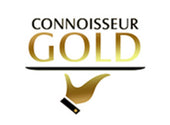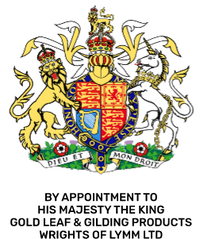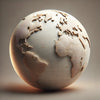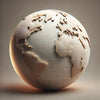Edible Gold Leaf Across the World - Kuwait
- by sam@wrightsoflymm.co.uk User
Introduction
In recent years, you may have noticed shimmering garnishes — thin sheets of gold leaf, tiny specks of gold flakes, or even a dusting of gold dust — presenting an air of luxury in desserts and beverages. But beyond the aesthetic appeal lies a story of cultural tradition, trade, and opulence that extends into the Gulf region, including Kuwait. This blog post explores the history and uses of edible metals in Kuwait: how 24 carat and 23 carat goldleaf, silver leaf, silver flakes, silver dust, and other precious-metal food decorations fit into Kuwaiti enjoyment, hospitality and celebration.
Historical Roots of Edible Metals in the Gulf
Although specific records for Kuwait are scarce, the use of edible gold and silver across the Arabian Gulf reflects wider regional practices:
-
Globally, the use of edible gold dates back thousands of years. For example, in ancient Egypt, gold was associated with divinity and immortality.
-
In the Islamic world and the Ottoman domain, gold-leaf decoration in food and architecture symbolised luxury and status.
-
In the neighbouring Gulf context, the use of gold leaf in architecture and design underlines how precious metals hold cultural importance. For instance, in the UAE the tradition of gilded interiors and food-decoration reflects this legacy.
For Kuwait, as part of the Gulf-Arab trade and hospitality culture, this means that edible gold and silver entered the local milieu via imported luxury goods and high-end dining. While indigenous sweets may not originally have been adorned with gold, with the modern globalisation of gourmet cuisine these shimmering decorations became accessible and desirable.
Types of Edible Metals: Gold Leaf, Silver Leaf & More
To understand usage in Kuwait, it helps to clarify the different forms and purities of edible metals:
Gold & Silver Purities
-
24 carat gold leaf: essentially pure gold, offering the brightest, softest finish.
-
23 carat gold leaf: slightly alloyed to give a firmer texture for handling, still safe for consumption in food-grade form.
-
Silver leaf: thin sheets of silver used for food decoration; though less common, it pairs visually with gold.
-
Gold flakes / silver flakes: smaller pieces of these metals, easier to apply to desserts and drinks.
-
Gold dust / silver dust: finely ground particles used to dust cakes or beverages for a shimmering effect.
Safety & Standards
It’s worth noting that edible gold is biologically inert — it passes through the body without being absorbed. Food-grade metal leaf must meet purity standards to avoid contamination. As structural evidence, Kuwait’s online retail channels show imported certified 23ct/24ct edible gold and silver dust targeted at celebrations.
Adoption & Uses in Kuwait
In Kuwait today, edible gold leaf (and silver variants) are seen in luxury dining, dessert styling, confectionery and even retail for home-celebration use.
Luxury Dining & Desserts
Governorate-level restaurants and high-end hotels in Kuwait may feature dishes garnished with gold leaf or gold flakes to signal prestige. While specific menus are not easily documented publicly, the broader Gulf practice informs that these accents elevate the dining experience. For example:
-
A dessert or pastry topped with a sheet of 24 carat goldleaf.
-
A premium chocolate or date-package featuring gold or silver flakes for high-value gifting.
Confectionery, Sweets & Celebrations
Kuwait, like its regional neighbours, reveres hospitality and special-occasion sweets. During weddings, engagements, festivals such as Eid, or corporate celebrations, sweet items decorated with goldleaf serve as symbols of prosperity and generosity. Indeed, retail kits in Kuwait allow home bakers to buy 24K edible gold leaf sheets, gold flakes, and gold dust for cake-decoration.
Visual Branding & Gifting Culture
In Kuwait’s gifting culture — especially in corporate, wedding and luxury sectors — items like gilded sweets or gold-accented food presentations carry a strong impression. The shine of goldleaf or silver-leaf signals refinement, affluence, and a desire to impress. It aligns with Gulf hospitality where presentation matters.
Cultural & Symbolic Significance
Why do edible gold and silver hold appeal in Kuwait? Several layers of meaning converge:
-
Luxury & Status: Using 24 carat or 23 carat goldleaf conveys exclusivity.
-
Generosity & Hospitality: In Kuwaiti culture, offering something visually striking is part of honouring guests.
-
Celebration & Festivity: Gold and silver decorations elevate the mood of weddings, engagements, Eid feasts — signalling that this is no ordinary occasion.
-
Aesthetic & Social Media Appeal: Modern diners expect photo-worthy indulgences; shining desserts with gold flakes fit this perfectly.
Practical Tips for Use in Kuwait
If you’re looking to incorporate gold leaf, flakes or dust into your own Kuwaiti celebration, here are some helpful pointers:
-
Purchase certified food-grade material (24 carat or 23 carat goldleaf, edible silver leaf) from reliable suppliers in Kuwait.
-
Use sparingly: a little goes a long way — gold flakes or dust are decorative rather than flavour-adding.
-
Apply at the end of preparation — gold leaf can wrinkle or melt if exposed to too much moisture or heat.
-
Pair with sweets, dates, chocolates, premium beverages — think of it as a finishing flourish.
-
Consider the cultural sensibility: ensure that your guests appreciate the aesthetic and understand it’s ornamental.
-
Store properly: keep in cool, dry place; handle with tweezers or brush to avoid waste.
Challenges & Considerations
While edible gold and silver are approved for consumption, keep in mind:
-
They add cost — using goldleaf or gold flakes increases the price of food.
-
Their appeal is largely visual; they offer no nutritional benefit.
-
Over-use may appear gimmicky rather than elegant — moderation is key for taste and style.
-
Ensure correct regulatory compliance in Kuwait (importation, certification, food-safety standards) when purchasing.
Conclusion
In Kuwait, the use of edible gold leaf, gold flakes, gold dust, as well as silver leaf, silver flakes and silver dust, reflects a blend of ancient luxury tradition and modern gourmet presentation. Whether it’s the gleam of 24 carat goldleaf atop a dessert or the subtle shimmer of silver flakes in a celebratory beverage, the symbolism of opulence, hospitality and festivity is unmistakable. As you explore or host culinary experiences in Kuwait, incorporating these precious-metal garnishes can elevate the moment — provided you use them thoughtfully.






